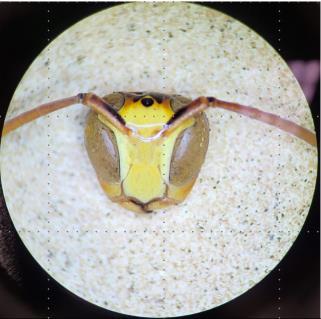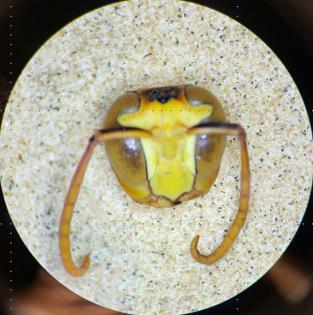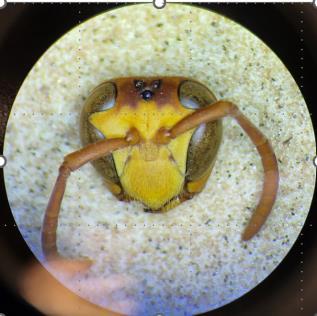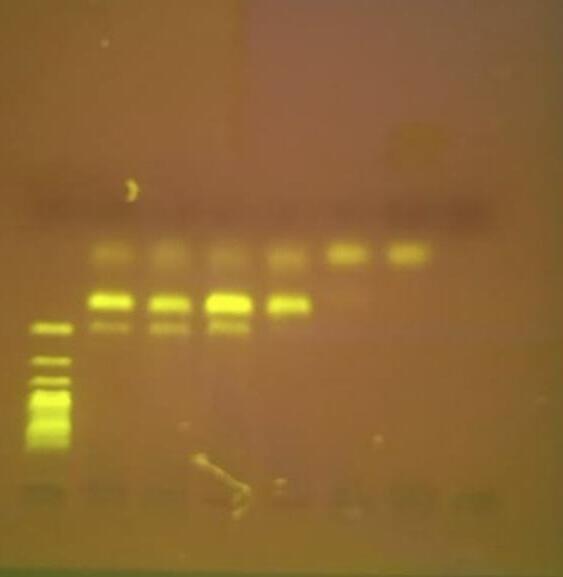
International Research Journal of Engineering and Technology (IRJET) e-ISSN:2395-0056
Volume: 12 Issue: 01 | Jan 2025 www.irjet.net p-ISSN:2395-0072


International Research Journal of Engineering and Technology (IRJET) e-ISSN:2395-0056
Volume: 12 Issue: 01 | Jan 2025 www.irjet.net p-ISSN:2395-0072
Niccole D. Rech1*, Juan Carlos Amaya2, Yessly Camunez2 , Charles Lobato2, Leo Robledo2, Angelec Winters2
1Western New Mexico University
2 Early College High School, Deming, New Mexico
ABSTRACT: During the summer of 2023, 115 Polistes carolina (Linnaeus, 1767) were captured in the Northern Chihuahua Desert. Ninety-twowerefemalesand23weremalesgivingasex-ratiodistortionofexactly4:1.Purposely,thequeenswerenot captured. Polistes carolina, a common paper wasp, is important for two main reasons. First, they are native pollinators that have not been inbred like the domesticated honeybee, Apis mellifera Therefore, they are more resistant to pathogens. Secondly,theyareinsectpredatorsandhelpcontrolinsectpopulations. InsectlarvaintheOrdersLepidopteraandDipteraare usually targeted. Sixty-nine Polistes carolina were tested for Wolbachia pipientis, an endosymbiont that is changing the evolutionofinsects.The16SrDNAgeneofthesmallunitofthebacterialribosomewastargetedtoidentify Wolbachia pipientis infection. For insect DNA, the cytochrome C oxidase gene was targeted. Fifty-six-point five percent tested positive for Wolbachia. One-hundred and eight Polistes carolina wasps’ facial markings were analyzed. Three facial marking categories were detected Facial marking in the genus Polistes have been linked to communication. Facial markings in several other species in this genus have been analyzed, but not Polistes carolina The wasps were identified using the Vespidae key from Buck,Marshall,andCheung(2020).
KEYWORDS: Wolbachia pipientis, Polistes carolina,FacialMarkinginPaperWasps
BACKGROUND:
Thereisadearthofinformationonthe Polistes carolina populationslivingintheNorthernChihuahuaDesert. Polistes carolina, a common ferrous colored paper wasp inhabits six continents and many oceanic islands (Reeve, 1991). Over the last several decades, these wasps have been studied to understand several behaviors including dominance hierarchy of reproduction (Jandt, Tibbetts, & Toth, 2014), the mechanisms of social communication (Cervo, Cini, & Turillazzi, 2015), and plasticity of socialbehavior(Patalano,Vlasova,Wyatt,Ewels,&Camara,2015). Polistes carolina arenon-specificnativepollinators(Sumner & Cini, 2021), and are important predators in terrestrial communities (Stahlhut, Liebert, Starks, Dapporto, & Jaenike, 2006). Theyareanessentialpartofecosystems. Polistes carolina mainlypreyonthelarvalstagesofOrdersDipteraandLepidoptera, whichinlargenumberscanbeagriculturalpests(Southon,Fernandes,Nascimento,&Sumner,2019).Withthedeclineof Apis melifera, the domesticated European honeybee, the preservation of native pollinators is imperative (Hoehn, Tscharntke, Tylianakis,&Steffan-Dewenter,2008).
Facial patterns have been shown to be a means of communications for some species of Polistes wasps. Differences in facial patternshavebeenlinkedtoindividualwaspidentity(Jernigan,Stafstrom,Zava,Vogt,&Sheehan,2023; Miller,2023).Wasps are limited in their visual acuity due to small, compound eyes (Land, 1997). Facial markings are used to identify nest mates, enemies,andsocialhierarchy.Facialrecognitionamongnestmatesisusedtoreduceconflictsandstabilizesocialinteractions (Tibbetts&Sheenan,2011). Facialcolorpatternsamong Polistes waspsincludeyellow,red-brownandblackmarkings(Miller, 2023).Facialpatterncommunicationshavebeenidentifiedinthreespeciesof Polistes wasps,butnot Polistes carolina.
Wolbachia pipientis is a rickettsia, alpha-proteobacteria endosymbiont that causes reproduction alterations that impact speciation(Knight,2001;Werren,1997).Itinfectsinsects,mites,crustaceans,andfilarialnematodes(Serbus,Casper-Lindley, Landmann,&Sullivan,2008).Although,itisnowknownthat Wolbachia cangothroughanextracellularphasethatcanlastup to seven days (Rasgon, Gamston, & Ren, 2006). Wolbachia causes cytoplasmic incompatibility, (LePage, et al., 2017; Werren, 1997) parthenogenesis, feminization, and male-killing (Hurst, et al., 1999: Werren, 1997) It can be transmitted horizontally

International Research Journal of Engineering and Technology (IRJET) e-ISSN:2395-0056
Volume: 12 Issue: 01 | Jan 2025 www.irjet.net p-ISSN:2395-0072
frompreytopredator,throughextracellularsurfaces,andverticallyfrommothertooff-spring(Rasgon,Gamston,&Ren,2006; Werren,1997). Besidescausingreproductivealterations, Wolbachia pipientis canblocknumerousdiseasesthatarecommonly transmitted by mosquitoes such as Zika virus, Dengue virus, Drosophila C virus, West Nile virus and many more (Frentiu, Robinson, Young, McGraw, & O’Neill, 2010; Iturbe-Ormactxe, Walker, & O’Neill, 2011). Also, Wolbachia has made some populationsofinsectsresistanttoinsecticidesandRNAviruses (Li,Lui,&Guo,2018;Pimentel,Cesar,Martins,&Cogni, 2021; Eleftherianos, Atri, Accetta, & Castillo, 2013). Females from several populations Polistes dominulus in Italy and the U.S. were testedforthe Wolbachia infectionsratesin2006. Theinfectionratesvariedimmensely. Italianwasps’infectionratesranged from33%to71%. TheU.S.populationsrangedfrom16%to87%(Stahlhut,Liebert,Starks,Dapporto,&Jaenike,2006).
Two millimeters (mm) were removed from the specimen’s abdomen. The abdominal segment was then placed in a 1.5 milliliters(mL)microfugetubewith200microliters(µL)oflysisbuffer.Theabdominalsegmentwasmaceratedfor1minute. Eight-hundredµLoflysisbufferwasaddedtothemicrofugetubethenvortexed.Thetubewasplacedina95°Cwaterbathfor5 minutes.Afterheating,thetubewasopenedbrieflytoreleasepressurethencentrifugedfor5minutesat10,000rpm.Another microfugetubewasobtainedand400µLofthesupernatantandputintothenewtube.FortyµLof5.0MNaClwasaddedand placedonicefor5minutes.Tubeswereplacedinthecentrifugeatthesame rpmandtimeaspreviouslystated.Anotherclean microfugetubewasobtainedand300µLofsupernatant wastransferred.Four-hundredmicrolitersofisopropanolwasadded and then centrifuged at 10,000 rpm for 5 minutes. The supernatant was carefully poured out and the mouth of tube was tappedlightlytoremovemostoftheliquid.Thetubewascentrifugedfor1minuteandtherestoftheliquidwaspipettedout. Thepelletwasairdriedfor10minutes.Two-hundredµLofTE/RNasewasadded.Thepelletwasdisturbedbypipetting then tube was centrifuged at 10,000 rpm for 1 minute. The DNA was frozen until PCR amplification. PCR amplification was done with a Bio-rad thermocycler t100. Five µL each of forward and reverse primer, 5 µL of insect DNA, and 10 µL of master mix wereaddedtoa0.2mLmicrofugetube.PCRcyclesincluded95degreesfor2minutes,30cyclesof:94degreesfor30seconds, 55degreesfor45seconds,72degreesfor1minute,then72degreesfor10minutes,andfinallyleftat4degreesfortherestof theallottedtime.GelGreenNucleicAcidStainwasaddedtothetwopercentagaroselithiumbromidegels.Theelectrophoresis chamber wasfilled with lithium bromide buffer. The gels were run at150 V for 30 minutes. Apearl biotech DNAilluminator wasusedtoviewtheDNA.
Five Polistes carolina wasp nests were located in a 5-hectare area of the Northern Chihuahuan Desert. A vacuum pump was usedtoextractafewwaspsfromeachnesteveryfewweekssoasnottodestroythenest.Thequeenwaspswerenotremoved. ThewaspswerefrozentopreventDNAdecay,thenplacedin50mLcentrifugetubesuntilbetestedfor Wolbachia pipientis and examinedforfacialmarkings.Safetyclothingwaswornatalltimes.
Collection Site:Thespecimenswerecollectedfroma5-hectarearea(~32.17ᵒN,107.63ᵒW)atanelevationof1400mfromthe bajada on the north side of the Florida Mountains. The mountains are an inactive fault-block range comprised of Paleozoic limestoneanddolomiterocks. Theareareceives~23.37cmofprecipitation. Thehightemperatureis~35.5ᵒC,andthelowis ~18.3ᵒC. The florae include creosote bushes, Larrea tridentate, Joshua trees, Yucca brevifolia, mesquite trees, Prosopis glandulosa,andseveralspeciesofthegenus Opuntia, pricklypearcacti.
One-hundred eight wasps were decapitated and the heads viewed under a dissecting microscope. Classification of the facial markings were basedon thedifferencelocationsof black lines on the edge of the clypeus, descending from the antenna,and alsoascendingfromthebaseoftheclypeustothebaseoftheeyes. Individualmarkingswerenoted,butdiscountedbecauseof thelimitednumbers.
The present study was done for two purposes. First, the evaluate the facial markings of Polistes carolina. Facial marking of several other Polistes species had been evaluated, but not P. carolina. Secondly, the study assesses the Wolbachia pipientis infectionrateof Polistes carolina intheNorthernChihuahuadesert.

International Research Journal of Engineering and Technology (IRJET) e-ISSN:2395-0056
Volume: 12 Issue: 01 | Jan 2025 www.irjet.net p-ISSN:2395-0072
Facial Markings: One-hundred eight Polistes carolina paper wasps were decapitated, viewed under a dissecting microscope andanalyzed.
Table1.NumberofmaleandfemalewaspswithAlpha,Beta,andGammamarkings



Figure1 (LtoR)Specimen#7Alphamarkings;Specimen#18Beta markings;Specimen#50Gammamarkings
Alpha identification includes black lines on the margin of the clypeus that start at the baseoftheclypeusandextend upwardtothebaseoftheeyes
Beta identification includes blacklineonthemarginofthe clypeus that start at the base of the clypeus and extend upwardstotheantenna

Gammaidentificationincludesablacklinestartingattheantennaanddescendingdowntotheeyemargin.
Wolbachia pipientis Infection Rate: Sixty-nine Polistes carolina wasps were tested for Wolbachia pipientis infection. For Wolbachia DNA identification, the 16S rDNA gene of the small ribosome unit was targeted for identification. For insect DNA identificationthecytochromeCoxidasegenewastargeted.Asecondbacteriuminfectionwasidentifiedbyelectrophoresisina fewofthespecimens.
Table2.Numberof Polistes carolina waspsinfectedwith Wolbachia pipientis

International Research Journal of Engineering and Technology (IRJET) e-ISSN:2395-0056
Volume: 12 Issue: 01 | Jan 2025 www.irjet.net p-ISSN:2395-0072



Figure 2 (Left) Is the electrophoresis get for specimens59through64.Theelectrophoresisgel,on the left, shows the 100 bp ladder then DNA from specimens59through64,inorder.TheinsectDNAis located furthest from the wells at 709 bp, and the Wolbachia DNA is located below the insect DNA at 438 bp. Specimens 59 through 62 are infected with Wolbachia. Another bacterium’s DNA is visible just below the Wolbachia DNA in specimens 59 through 61. Beings we targeted the 16S rDNA gene in bacterium and there are variations in the sequence with different bacterium, the primer we used picked an unidentified bacterium in specimens 59, 60 and 61. The university laboratory did not have the equipment or reagents necessary to identify the bacterium.

During thesummerof 2023,108 Polistes carolina paper wasps were capturedfrom variousnests intheNorthernChihuahua Desert.Facialmarkingsareonemethodofcommunicationusedin Polistes wasps.Severalspeciesoffacialmarkingsin Polistes waspshavebeenanalyzed,butnot Polistes carolina Asmentionedearlier,thefacialmarkingsof Polistes carolina havenotbeen analyzed or published. Also, purposely the queens were not captured, and only a few specimens were captured at one time fromeachnesttopreventharmingthenests.
Three distinct facial marking were observed, 2 Alpha, 21 Beta, and 85 Gamma (Table 1, Figure 1). It seems obvious that Gammafacialmarkingdenotes“workers”. Theymade-upalmost79%ofthewaspscaptured. ThefemalewithAlphamarkings must have been a “foundress”, a potential queen for a nest. The male is a quandary, but with such a small sample it is impossible to make any realistic assessment. More research is needed to ascertain the status of males with Alpha markings. Nineteen percent of the wasps have Beta markings. These wasps must have been captured while the nest was in its reproductivestage.Allofthewaspshadyellowfaceswiththeexceptionoftheblacklines.
Sixty-nine Polistes carolina waspsweretestedfor Wolbachia pipientis, 16maleand53female(Table2).Toanalyzetheinfection rate,theDNAwasrunthroughanagarosegelat150Vfor30minutes. InsectDNAwasvisibleinbandsat 709base-pairs(bp) and Wolbachia wasvisibleat438bp(Figure2). Specimens59through64electrophoresisgel(Figure2)showsthatspecimens 59through62 wereinfectedwith Wolbachia pipientis. Specimens59,60and61wereinfectedwitha secondbacteria,which showedupatabout400bp. However,wedidnothavethereagentsnecessarytoidentifyit.Fifty-four-pointsevenpercentof the wasps were infected with Wolbachia, which aligns with the average infection rate across all insect species globally. Interestingly, Aedes aegypti collected in thesame area hadthe exact samerate of Wolbachia infection (Kulkarni, etal.,2018). However, the infection rate of several Polistes species tested in the U.S. varied from 16% to 87% (Stahlhut, Liebert, Starks, Dapporto,&Jaenike,2006).
Whenthegonadswereremoved,mostofthe Polistes carolina secretedaclearpurpleliquid.Itwasanticipatedthattheliquid was a reducing sugar. To verify that, the liquid was collected and analyzed with Benedict’s reagent. The solution turned a brown/redcolorwhichdeterminedthatthesolutionwasindeedreducingsugar.
Moreresearchisneededonthe Polistes carolina waspsintheNorthernChihuahuaDesert,especiallywiththefacialmarkings and Wolbachia pipientis infection rate. Presently, there is very little research being done on the insects inhabiting this desert region Wolbachia pipientis, thefastestspreadingendosymbiontontheplanet,hasaninfectionrateofapproximately50%inall insect species tested which includes Africanized Honey Bees (Rech, et al. 2020), Brachystola magna (Rech, et al., 2022), a

International Research Journal of Engineering and Technology (IRJET) e-ISSN:2395-0056
Volume: 12 Issue: 01 | Jan 2025 www.irjet.net p-ISSN:2395-0072
lubbergrasshopperand Hyles lineata (Rech,etal.,2023),asphinxmoth,and Ades aegypti (Kulkarni,etal.,2018) amosquito Otherinsectpopulationsmustbetestedtoascertainthespreadof Wolbachia inthisregion.
Researchintofacialmarkingson Polistes waspsisanemergingarea,whichneedstobeexpanded. Fewresearchershavedelved into this topic. The waspsareecologicallyimportantas both non-specific pollinatorsandinsectcontrol. Our researchshows threemajorgroupings,workerswithGammafacialmarkings,individualscapturedinthenests’reproductivephasewith Beta markings, and the two wasps with Alpha markings. The female with Alpha marking was probably a foundress or potential queen. More studies have to be done to unravel the mystery of the male with Alpha markings. However, only two wasps capturedhadAlphamarkingswhichistoosmallofasampletomakeconclusions.
References
Buck,M.,Marshall,S.,& Cheung,D.(2020).AtlasoftheVespidae(Hymenoptera,Aculeata)ofthenortheasterNearcticregion. Canadian Journal of Arthropod Identification, 5,492.
Cervo,R.,Cini,A.,&Turillazzi,S.(2015).Visualrecognitioninsocial wasps.InL.Aquiloni,& E.Tricarico, Social recognition in invertebrates (pp.125-145).Cham:Springer.
Eleftherianos, I., Atri, J., Accetta, J., & Castillo, J. (2013). "Endosymbiotic bacteria in insects" guardians of the immune syste Frontiers in Physiology, 4,1-8.
Frentiu,F.,Robinson,J.,Young,P.,McGraw,E.,&O'Neill,S.(2010). Wolbachia-mediatedresistancetodenguevirusinfectionand deathatthecellularlevel. Plos One, 5(10),1-8.
Hoehn, P., Tscharntke, T., Tylianakis, J., & Steffan-Dewenter, I. (2008). Functional group diversity of bee pollinators increases cropyield. Proceedings of the Royal Society: Biology, 275,2283-2291.
Hurst,G.,Jiggins,F.,Schulenburg,G.,Dominique,B.,West,S.,Goriacbeva,I.,&Majerus,M.(1999).Male-killing Wolbachia intwo speciesofinsects. The Royal Society, 266(1420),735-741.
Iturbe-Ormaetxe,I.,Walker,T.,&O'Neill,S.(2011). Wolbachia andthebiologicalcontrolofmosquito-bornedisease. European Molecular Biology Organization, 12(6),508-518.
Jandt, J., Tibbetts, E., & Toth, A. (2014). Polistes paper wasps: a model genus for the study of social dominance hierarchies. Insectes Sociaux, 61,11-27.
Jernigan, C., Stafstrom, J., Zaba, N., Vogt, C., & Sheehan, M. (2023). Color is necessary for face discrimination in the Northern paperwasp, Polistes fuscatus Animal Cognition, 29(2),589-598.
Knight.(2001).MeettheHerodbug. Nature, 412,12-14.
Kulkarni, A., Yu, W., Jiang, J., Sanchez, C., Karna, A., Martinez, K., & Duguma, D. (2019). Wolbachia pipientis occurs in Aedes adgypti populationinNewMexicoandFlorida,USA. Ecology and Evolution,148-156.
Land,M.(1997).Visualacuityininsects. Annual Review of Entomology, 42,147-177.
LePage, D., Metcalf, J., Bordenstein, S., On, J., Perimutter, J., Shropshire, D., & Bordenstein, S. (2017). Prophage WO genes recapitulateandenhance Wolbachia inducedcytoplasmicincompatibility. Nature, 543,243-247.
Li, Y., Lui, X., & Guo, H. (2018). Variation in Endosymbiont infection between buprofezin-resistant and susceptible strains of Laodelphax striatellus (Fallen). Current Microbiology, 75,709-715.
Miller,S.(2023).Facialcolordiversityof Polistes paperwasps. Insectes Sociaux, 70,181-190.
Patalano, S., Vlasova, A., Wyatt, C., Ewels, P., & Camara, F. (2015). Molecular signatures of plastic phenotypes in two eusocial insectspecieswithsimplesocieties. Proceeding of the National Academy of Sciences of the U.S.A., 112,13970-13975.

International Research Journal of Engineering and Technology (IRJET) e-ISSN:2395-0056
Volume: 12 Issue: 01 | Jan 2025 www.irjet.net p-ISSN:2395-0072
Pimentel, A., Cesar, C., Martins, M., & Cogni, R. (2021). The antiviral effects of the symbiont bacteria Wolbachia in insects. Frontiers in Immunology, 11,1-5.
Rasgon,J.,Gamston,C.,&Ren,X.(2006).Survivalof Wolbachia inacell-freemedium. Applied and Environmental Microbiology, 72(11),6934-6937.
Rech,N.,Au,M.,Caballero,L.,Cardoza,J.,Coloma,F.,&Lozano,J.M.(2022).ImplicationsoftheInfestationRatesof Wolbachia pipientis and Oxyspirura petrowi in Brachystola magna as related to the percentage of eyeworm disease in northern bobwhitequail(Colinus virginianus). International Research Journal of Engineering and Technology, 9(7),2857-2863.
Rech, N., Baca, K., Cardoza, P., Figueroa, K., Lobato, C., Martinez, J., & Winters, A. (2023). Proboscis variation and Wolbachia pipientis infection rate of Hyles lineata in the Northern Chihuahuan Desert. International Journal of Science, Environment and Technology, 12(5),96-104.
Rech,N.,Darrow,A.,Lopez,A.,Mendoza,D.,Nicoll,V.,&Paulk,L.(2020).Prevalenceof Wolbachia pipientis and Varroa destrictor mites in Africanized Bees in the Deming, New Mexico Area. International Journal of Science, Environment and Technology, 9(2),274-284.
Reeve,H.(1991). Polistes.InR.Matthew,&K.Ross, The social biology of wasps (pp.99-148).Ithaca:CornellUniversityPress.
Serbus,L.,Casper-Lindley,C.,Landmann,F.,&Sullivan,W.(2008).Thegeneticsandcellbiologyof Wolbachia-hostinteractions. The Annual Review of Genetics, 42,683-707.
Southon,R.,Fernandes,O.,Nascimento,F.,&Sumner,S.(2019).Socialwaspsareeffectivebiocontrolagentsofkeylepidipteran croppests. Proceedings of the Royal Society Biology, 286,1-8.
Stahlhut, J., Liebert, A., Starks, P., Dapporto, L., & Jaenike, J. (2006). Wolbachia in the invasive European paper wasp Polistes dominulus Insectes Sociaux, 53,269-273.
Sumner, S., & Cini, A. (2021). Paper Wasps (Polistes). In C. Starr, Encyclopedia of Social Insects (pp. 698-766). Bern: Springer NatureSwitzerland.
Tibbetts, E., & Sheehan, M. (2011). Facial Patterns are a conventional signal of agonistic ability in Polistes exclamans paper wasps. International Journal of Behavioural Biology, 117,1138-1146.
Werren,J.(1997).Biologyof Wolbachia Annual Review of Entomology, 42,587-609.